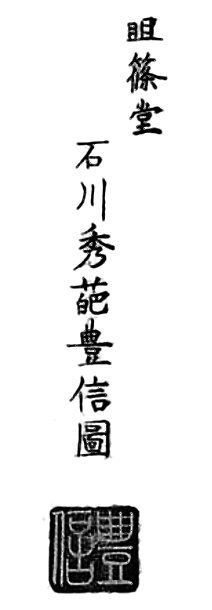| |
TOYONOBU Ishikawa(1711 - 1785)Biography "drawn by Tanjôdô Ishikawa Shûha Toyonobu" ("Tan jô dô Ishikawa Shûha Toyoshige-zu", "胆條堂石川秀芭豊信図") TOYONOBU Ishikawa, Seal and Signature |
|
| |
||
Artist – TOYONOBU
Ishikawa (石川 豊信, 1711 - 1785) was a Japanese
ukiyo-e print artist. He was a
pupil of Nishimura Shigenaga (西村重長). TOYONOBU
is sometimes said to have been the same person as Nishimura
Shigenobu, a contemporary ukiyo-e artist and student of
Nishimura Shigenaga about whom very little is known. He
produced many monochrome "lacquer prints" (urushi-e) which
reflected the influence of Okumura Masanobu as well. He is
known for his virtuoso use of benizuri-e (紅摺絵), printmaking
using two colors, pink and green as a precursor of four colour
ptinting technique. TOYONOBU
happens also to appeal to a particular technique of gathering
in parts of triptych prints already edited elsewhere, making
it possible to let severals artists work on the same print.
Many of his works were yakusha-e (actor prints) and bijin-ga (images of beautiful women), including images of standing courtesans, whose faces conveyed an impassivity typical of the works of the Kaigetsudō school. Toyonobu also experimented with semi-nude forms, something his chief predecessors also did, but never succeeded in developing it into a trend or sub-genre within ukiyo-e. Art historians point out that these images, depicting women with the top half of their kimono open and let down to reveal their chests, were intended as suggestive and erotic, and were not "glorification of the human form such as we find in Greek art." Later in his career, Toyonobu became one of the leading producers of color prints, chiefly benizuri-e ("rose prints"), but stopped producing ukiyo-e shortly after Suzuki Harunobu pioneered the full-color print (nishiki-e) in 1765.
Personal life - On the life of Ishikawa Toyonobu were inaccurate information. TOYONOBU Ishikawa (石川 豊信) was born ISHIKAWA Magosaburo (石川 孫三郎) in 1711, with the given name "Toyonobu" and the common name Nukaya Shichibee (糠屋七兵衛). Presumably the artist was born in samurai family and studied with Nishimura Sigenagy. TOYONOBU is often associated with the artist under the pseudonyms "Magasaburo Nishimura" (1730) and "Nishimura Shigenobu" (1730-1747). Since 1747, he is known under the name of "TOYONOBU Ishikawa". He was married and had at least one son, presumably Ishikawa Toyomasa (石川 豊正 or 石川豊雅). In the mid-1760s, TOYONOBU Ishikawa inherited a hotel on the outskirts of Edo from his father-in-law, and gradually more or less ceased completely to painting. He died in his 75th year, and is buried in Tokyo's Shokokuji Temple (正覚寺) in Daitōku Kuramae (台東区蔵前). His posthumous Buddhist name is Yasutaka Satoru okina (泰誉覚翁).
Aliases - ISHIKAWA Magosaburo (石 川 孫三郎) as childhood name, TOYONOBU Ishikawa (石川 豊信) as main "ga"-name with several epithets (cf. signature), Nukaya Shichibee (糠屋七兵衛) and several attributed pseudonyms as "Magasaburo Nishimura" (1730) and "Nishimura Shigenobu" (1730-1747).
Disciples - Known disciples were Ishikawa Mukashishin (石川昔信), Ishikawa YutakaMasashi (石川豊雅) and the most notable pupil, Ishikawa Toyomasa (石川 豊正 or 石川豊雅, active 1770 - 1790). Ishikawa Toyomasa is known for his depictions of children at play, and who may have been TOYONOBU's son. He is also known for his Kyōka (狂歌, "wild" or "mad poetry"), a popular and parodic subgenre of the tanka form of Japanese poetry.
zurueck zur Hauptseite / back to main page
Many of his works were yakusha-e (actor prints) and bijin-ga (images of beautiful women), including images of standing courtesans, whose faces conveyed an impassivity typical of the works of the Kaigetsudō school. Toyonobu also experimented with semi-nude forms, something his chief predecessors also did, but never succeeded in developing it into a trend or sub-genre within ukiyo-e. Art historians point out that these images, depicting women with the top half of their kimono open and let down to reveal their chests, were intended as suggestive and erotic, and were not "glorification of the human form such as we find in Greek art." Later in his career, Toyonobu became one of the leading producers of color prints, chiefly benizuri-e ("rose prints"), but stopped producing ukiyo-e shortly after Suzuki Harunobu pioneered the full-color print (nishiki-e) in 1765.
Personal life - On the life of Ishikawa Toyonobu were inaccurate information. TOYONOBU Ishikawa (石川 豊信) was born ISHIKAWA Magosaburo (石川 孫三郎) in 1711, with the given name "Toyonobu" and the common name Nukaya Shichibee (糠屋七兵衛). Presumably the artist was born in samurai family and studied with Nishimura Sigenagy. TOYONOBU is often associated with the artist under the pseudonyms "Magasaburo Nishimura" (1730) and "Nishimura Shigenobu" (1730-1747). Since 1747, he is known under the name of "TOYONOBU Ishikawa". He was married and had at least one son, presumably Ishikawa Toyomasa (石川 豊正 or 石川豊雅). In the mid-1760s, TOYONOBU Ishikawa inherited a hotel on the outskirts of Edo from his father-in-law, and gradually more or less ceased completely to painting. He died in his 75th year, and is buried in Tokyo's Shokokuji Temple (正覚寺) in Daitōku Kuramae (台東区蔵前). His posthumous Buddhist name is Yasutaka Satoru okina (泰誉覚翁).
Aliases - ISHIKAWA Magosaburo (石 川 孫三郎) as childhood name, TOYONOBU Ishikawa (石川 豊信) as main "ga"-name with several epithets (cf. signature), Nukaya Shichibee (糠屋七兵衛) and several attributed pseudonyms as "Magasaburo Nishimura" (1730) and "Nishimura Shigenobu" (1730-1747).
Disciples - Known disciples were Ishikawa Mukashishin (石川昔信), Ishikawa YutakaMasashi (石川豊雅) and the most notable pupil, Ishikawa Toyomasa (石川 豊正 or 石川豊雅, active 1770 - 1790). Ishikawa Toyomasa is known for his depictions of children at play, and who may have been TOYONOBU's son. He is also known for his Kyōka (狂歌, "wild" or "mad poetry"), a popular and parodic subgenre of the tanka form of Japanese poetry.
Copyright 2008 ff: Hans P. Boehme